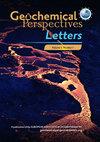过去3 Gyr上层大陆地壳的恒定铁同位素组成
IF 3.7
1区 地球科学
Q1 GEOCHEMISTRY & GEOPHYSICS
引用次数: 2
摘要
https://doi.org/10.7185/geochemlet.2221沉积年龄从中太古代到古生代的24种冰川杂岩复合物的Fe同位素组成是平均上大陆地壳(UCC)的代表,可用于跟踪δ56Fe在大陆地壳中随时间的变化。杂岩具有较高的化学蚀变指数(CIA)值和风化风化层的其他特征(例如,可溶性元素(如Sr)的强烈贫化),这些特征是从其上部地壳源区继承的。杂岩复合物中的δ56Fe值范围为-0.59‰至0.23‰。不包括三个受Fe地层物质结合影响的样品,杂岩的平均δ56Fe为0.12±0.13‰(2σ),与最近估计的上大陆地壳的平均δ56 Fe 0.09±0.03‰(2 s.d.)重叠(Dauphas et al.,2017,及其参考文献)。δ56Fe与CIA无明显相关性。我们的数据表明,在整个地球历史上,上大陆地壳的Fe同位素组成一直相对恒定,化学风化在上大陆地壳中产生Fe同位素变化并不重要。大氧化事件前缺氧风化,当铁以二价状态溶解时,在上部大陆地壳中,没有产生与大氧化事件后氧化风化环境不同的铁同位素特征。因此,在各种海洋沉积记录中观察到的大量铁同位素分馏可能是由于海洋中发生的过程(例如生物活动),而不是大陆上的非生物氧化还原反应。2021年3月4日收到| 2022年4月28日接受| 2022年6月10日发布本文章由计算机程序翻译,如有差异,请以英文原文为准。
Constant iron isotope composition of the upper continental crust over the past 3 Gyr
https://doi.org/10.7185/geochemlet.2221 The Fe isotopic composition of twenty four glacial diamictite composites with depositional ages ranging from theMesoarchean to the Palaeozoic serve as proxies of the average upper continental crust (UCC) and can be used to track how δ56Fe may have changed in the continental crust through time. The diamictites have elevated chemical index of alteration (CIA) values and other characteristics of weathered regoliths (e.g., strong depletion in soluble elements such as Sr), which they inherited from their upper crustal source regions. The δ56Fe values in the diamictite composites range from −0.59 ‰ to þ0.23 ‰. Excluding three samples impacted by the incorporation of materials from Fe formations, the diamictites have an average δ56Fe of 0.12 ± 0.13 ‰ (2σ), overlapping the recent estimated average δ56Fe of 0.09 ± 0.03 ‰ (2 s.d.) in the upper continental crust (Dauphas et al., 2017, and references therein). There is no obvious correlation between δ56Fe of the glacial diamictites and the CIA. Our data suggest that the Fe isotope composition of the upper continental crust has been relatively constant throughout Earth history and that chemical weathering is not important in producing Fe isotope variations in the upper continental crust. Pre-Great Oxidation Event (GOE) anoxic weathering, when iron was soluble in its divalent state, did not generate different Fe isotopic signatures from the post-GOE oxidative weathering environment in the upper continental crust. Therefore, the large Fe isotopic fractionations observed in various marine sedimentary records are likely due to processes occurring in the oceans (e.g., biological activity) rather than abiotic redox reactions on the continents. Received 4 March 2021 | Accepted 28 April 2022 | Published 10 June 2022
求助全文
通过发布文献求助,成功后即可免费获取论文全文。
去求助
来源期刊

Geochemical Perspectives Letters
Earth and Planetary Sciences-Geochemistry and Petrology
CiteScore
7.00
自引率
2.00%
发文量
42
审稿时长
15 weeks
期刊介绍:
Geochemical Perspectives Letters is an open access, internationally peer-reviewed journal of the European Association of Geochemistry (EAG) that publishes short, highest-quality articles spanning geochemical sciences. The journal aims at rapid publication of the most novel research in geochemistry with a focus on outstanding quality, international importance, originality, and stimulating new developments across the vast array of geochemical disciplines.
 求助内容:
求助内容: 应助结果提醒方式:
应助结果提醒方式:


